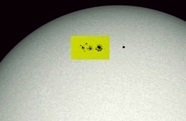![]()
- - text and links as of last publication - -
| CAUTION! OBSERVING A TRANSIT IS DANGEROUS AND MAY CAUSE IRREVERSIBLE EYE DAMAGE, UP TO BLINDNESS! Observing a transit necessitates the use of the DEDICATED SAFE TECHNIQUES recommended for the observation of a solar eclipse! |
On May 9th, 2016, Mercury is transiting the Sun. That astronomical event is a rare one as such occurrences are seen 13 times a century only; next ones, for example, will only occur by 2019 then 2032. Don't miss that show when available for your location! A transit, in astronomy, is when an inferior planet, like Venus or Mercury -a planet, that is, which is located between the Earth and the Sun- is seen, in perspective, transiting against the background of the Sun, as seen from the Earth. For a transit to occur, the inferior planet must be at a inferior conjunction and crossing the line of nodes. A Mercury transit further may occur either when the planet is at its perihelion -the closest Sun- or a aphelion -the farthest- which in the latter case -which is the case of the May 9th, 2016 transit- yields a larger apparent diameter of 12" for Mercury as Mercury is closest to Earth. check more about transits of inferior planets theoretically with our Venus and Mercury Transits tutorial
A transit is a fine show, giving a sense of the scales in the solar system as transits, on a other hand, generally, now serve to test techniques which are useful to detect exoplanets. Observing a transit consists into checking the entrance of the planet unto the solar disk, the transit's greatest -when the planet reaches to its closest the solar disk's center, and, eventually, the exit of the planet from the disk. The total duration of that transit is of 7 hour and 30 minutes as that 2016 transit is about a mean one in terms of the transit's greatest, with Mercury at 318.5" away from the solar disk's center. May 9th, 2016 Mercury transit will be observable in its entirety either side of the Atlantic Ocean, in central and eastern Canada, eastern U.S.A., West Indies, a major part of South America, western Europe and westernmost parts of West Africa! Either side of that area, the transit will be seen interrupted by sunset or already unfolding by sunrise. Eastern Europe, most of Africa, Russia, the Middle East, Central Asia, India, Mongolia, western parts of China and parts of Southeast Asia belong to the first case. Eastern Canada, Alaska, central and western U.S.A., Mexico, most of Central America, shores of Ecuador and Perou and the southernmost cone of South America to the second. There will be no transit visible for southeasternmost Siberia, Koreas, Japan, eastern China, most of Southeast Asia, Indonesia, Australia and New Zealand. Mercury apparent diameter will be only 1/194 that of the Sun. A telescope with a magnification of 50x to 100x is recommended. If Hydrogen-alpha filtration is available, the planet may be visible against either prominences or the chromosphere before and after contacts I and IV respectively. check more about transits of inferior planets in terms of observation with our Venus and Mercury Transits tutorial. The following illustration is showing how Mercury is looking like in front of the Sun during a November transit, when Mercury is displaying a apparent diameter of10". It will help for your telescope and photography gear's choice, with Mercury in 2016 at 2 arcminutes larger! Picture of a sunspots area is also given
 | How a November transit at 10" is looking like, which will help for your telescope and photography gear's choice with Mercury in 2016 at 2 arcminutes larger! Picture of a sunspots area is also given site 'Amateur Astronomy' |
| transit duration: | 07h 30m |
| Mercury apparent diameter: | 12" |
| contact I: | 11:12:19 UT |
| contact II: | 11:15:31 UT |
| greatest (or "minimum separation"; instant when Mercury passes closest to Sun's center) | 318.5 arcseconds |
| greatest time: | 14:57:26 UT |
| contact III: | 18:39:14 UT |
| contact IV: | 18:42:26 UT |
 | click to a chart for the May 9th, 2016 Mercury transit -with world visibility. ticks from 15mn into 15mn with hours in UT. The "position angle" is the direction of Mercury with respect to the center of the Sun's disk as measured counterclockwise from the celestial north point on the Sun. map courtesy Eclipse Wise, Espenak's new personal website |
for more about that transit and about Mercury transits generally, you may also see at NASA Eclipse Web Site or at Eclipse Wise, Espenak's new personal website
Website Manager: G. Guichard, site 'Amateur Astronomy,' http://stars5.6te.net. Page Editor: G. Guichard. last edited: 1/1/2016. contact us at ggwebsites@outlook.com